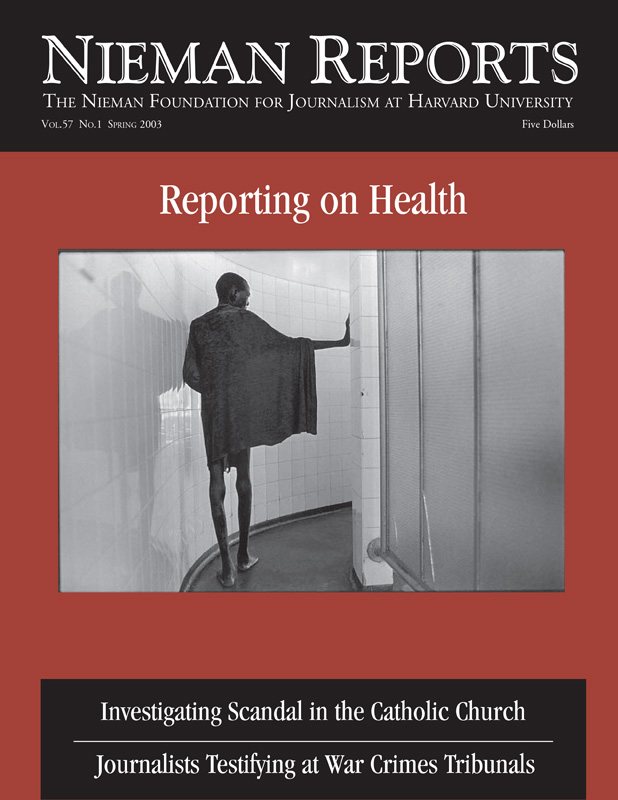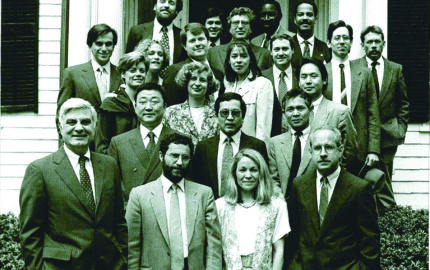The American press has a tendency to underreport its own story. Right now this means that as the Federal Communications Commission (FCC) proposes to change the rules governing ownership of local television stations, the public is being left largely in the dark. Normally, the press would love to report this story about powerful conglomerates and a concentration of markets and questions about how well the public will be served. But many of the players in this story are big media companies, whose newspapers and broadcast outlets seem to be shying away from their obligation to help readers and viewers anticipate what the changes might mean for them.
A decision by the FCC is expected this year. If the proposed changes are approved, a single corporation could own newspapers, radio and TV stations in one community. It is possible, too, that a single company could control access to more than 35 percent of all TV households in the nation. The current rules were established in an era when local citizens had fewer choices: typically, three TV stations and a couple of newspapers. There were many independent owners and few giant media corporations. The FCC argues that it wants to modernize its rules to accommodate new technologies such as the Internet and satellite transmission of sound and video images.
Those who support the rule changes argue that worries about monopoly control are unfounded. In its filing to the FCC, Gannett documents the experience of KNPX-TV and The Arizona Republic in Phoenix in which resources are shared on major breaking stories, though the news staffs usually operate competitively. Gannett argues that the community is better served on big stories by this collaboration.
Critics fear the changes are being pushed along too fast, without sufficient input from the public and without indepth reporting in the press. They fear there will be less diversity of programming in local markets, based on the experience of radio after the FCC liberalized group ownership rules in 1996. Before then, independent ownership was the standard. The largest group controlled fewer than 65 radio stations: Now Clear Channel Communications dominates radio station ownership with 1,225 stations. Moreover, the number of station owners has dropped by onethird. And, when a huge corporation takes over a local station, there tends to be less interest in local news coverage.
Such sweeping changes in how the public’s airwaves are used require a national debate. Newspaper editorials and broadcast commentators should urge FCC Chairman Michael Powell to schedule a series of discussions. Frank A. Blethen, Media Ownership and the Quality of News As the Federal Communications Commission considers changing rules, journalists need to pay better attention. publisher of The Seattle Times, is building a grassroots organization called “Voices of Concern” in an effort to preserve “diverse control and independence of the nation’s press and of the nation’s channels of information distribution.” His is among a growing number of voices critical of America’s newspapers for failing to tell this story. “The silence is deafening,” he says.
The FCC’s contention that technology and the growth of broadcast outlets has increased the diversity of choice in local markets is challenged by those who define diversity not just by measuring such numbers. Critics contend that communities of color are still being marginalized in coverage, and people of color are underrepresented on news staffs and in the ownership of broadcast properties. In its brief, the National Association of Hispanic Journalists argues that the “FCC has not spent enough time examining the role and function of news in our society or how rewriting the broadcast ownership regulations will affect the quality of news being produced.” The value of this brief is the questions it asks the FCC to address about how the rule changes would affect ethnic and racial communities. Organizations representing African-American, Asian-American and Native-American journalists are joining forces to bring their concerns to this debate.
To some extent, the FCC and organizations asking for a broad dialogue about relaxing media ownership rules, might be talking past one another. The FCC narrowly defines its responsibility as writing rules to accommodate a broadcast marketplace driven by new technologies. The FCC does not think it needs to consider the meaning of failed media mergers or anticipate how the market might react to less restrictive rules. Nor is it likely to consider whether local broadcast news organizations might have higher news values under newspaper ownership than as part of a company without deep roots in journalism.
The grassroots groups want to bring to hearings and public forums an urgent plea for the FCC to embrace as part of its decision the need for diverse, independent and serious broadcast journalism. They hope, too, the nation’s press will finally pay attention. The absence of a national debate and the disinterest of the press suggest that, in a few years, as new concentrations of media power emerge, journalists might look back at this time and ask themselves, “Why weren’t we better watchdogs for the public when these changes were proposed?”
A decision by the FCC is expected this year. If the proposed changes are approved, a single corporation could own newspapers, radio and TV stations in one community. It is possible, too, that a single company could control access to more than 35 percent of all TV households in the nation. The current rules were established in an era when local citizens had fewer choices: typically, three TV stations and a couple of newspapers. There were many independent owners and few giant media corporations. The FCC argues that it wants to modernize its rules to accommodate new technologies such as the Internet and satellite transmission of sound and video images.
Those who support the rule changes argue that worries about monopoly control are unfounded. In its filing to the FCC, Gannett documents the experience of KNPX-TV and The Arizona Republic in Phoenix in which resources are shared on major breaking stories, though the news staffs usually operate competitively. Gannett argues that the community is better served on big stories by this collaboration.
Critics fear the changes are being pushed along too fast, without sufficient input from the public and without indepth reporting in the press. They fear there will be less diversity of programming in local markets, based on the experience of radio after the FCC liberalized group ownership rules in 1996. Before then, independent ownership was the standard. The largest group controlled fewer than 65 radio stations: Now Clear Channel Communications dominates radio station ownership with 1,225 stations. Moreover, the number of station owners has dropped by onethird. And, when a huge corporation takes over a local station, there tends to be less interest in local news coverage.
Such sweeping changes in how the public’s airwaves are used require a national debate. Newspaper editorials and broadcast commentators should urge FCC Chairman Michael Powell to schedule a series of discussions. Frank A. Blethen, Media Ownership and the Quality of News As the Federal Communications Commission considers changing rules, journalists need to pay better attention. publisher of The Seattle Times, is building a grassroots organization called “Voices of Concern” in an effort to preserve “diverse control and independence of the nation’s press and of the nation’s channels of information distribution.” His is among a growing number of voices critical of America’s newspapers for failing to tell this story. “The silence is deafening,” he says.
The FCC’s contention that technology and the growth of broadcast outlets has increased the diversity of choice in local markets is challenged by those who define diversity not just by measuring such numbers. Critics contend that communities of color are still being marginalized in coverage, and people of color are underrepresented on news staffs and in the ownership of broadcast properties. In its brief, the National Association of Hispanic Journalists argues that the “FCC has not spent enough time examining the role and function of news in our society or how rewriting the broadcast ownership regulations will affect the quality of news being produced.” The value of this brief is the questions it asks the FCC to address about how the rule changes would affect ethnic and racial communities. Organizations representing African-American, Asian-American and Native-American journalists are joining forces to bring their concerns to this debate.
To some extent, the FCC and organizations asking for a broad dialogue about relaxing media ownership rules, might be talking past one another. The FCC narrowly defines its responsibility as writing rules to accommodate a broadcast marketplace driven by new technologies. The FCC does not think it needs to consider the meaning of failed media mergers or anticipate how the market might react to less restrictive rules. Nor is it likely to consider whether local broadcast news organizations might have higher news values under newspaper ownership than as part of a company without deep roots in journalism.
The grassroots groups want to bring to hearings and public forums an urgent plea for the FCC to embrace as part of its decision the need for diverse, independent and serious broadcast journalism. They hope, too, the nation’s press will finally pay attention. The absence of a national debate and the disinterest of the press suggest that, in a few years, as new concentrations of media power emerge, journalists might look back at this time and ask themselves, “Why weren’t we better watchdogs for the public when these changes were proposed?”



